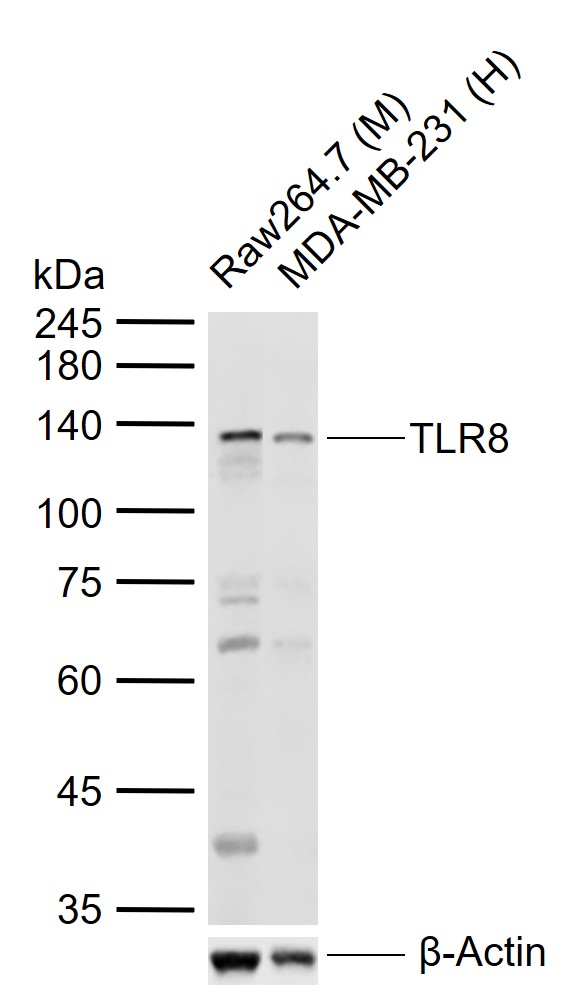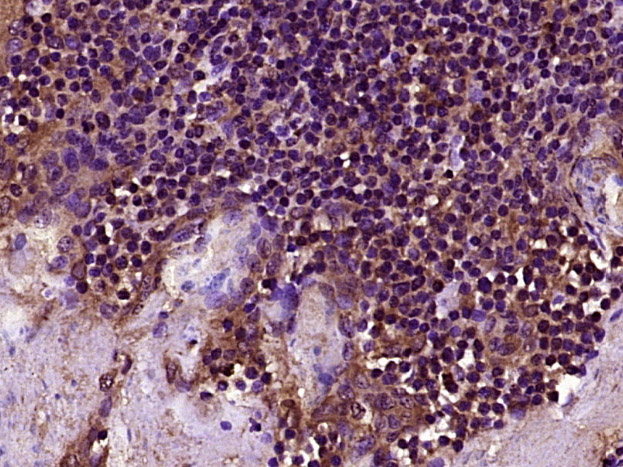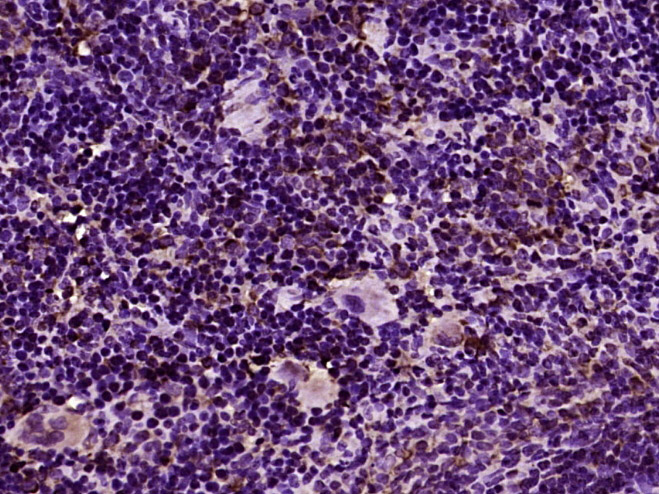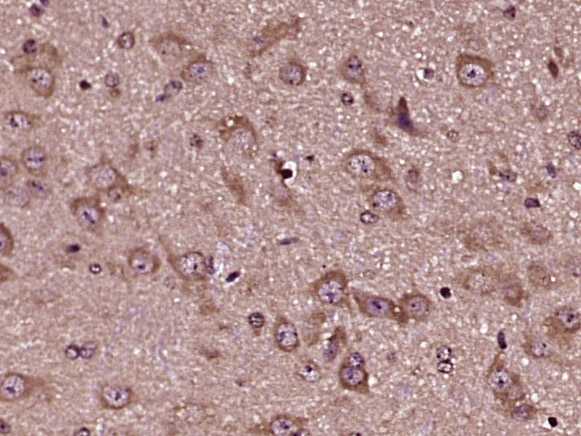
Rabbit Anti-TLR8 antibody
CD 288; CD288; CD288 antigen; MGC119599; MGC119600; TLR 8; TLR-8; Tlr8; TLR8_HUMAN; Toll Like Receptor 8; Toll-like receptor 8.
View History [Clear]
Details
Product Name TLR8 Chinese Name Toll样受体8抗体 Alias CD 288; CD288; CD288 antigen; MGC119599; MGC119600; TLR 8; TLR-8; Tlr8; TLR8_HUMAN; Toll Like Receptor 8; Toll-like receptor 8. Research Area Tumour Cell biology immunology Cyclin The cell membrane受体 Cell differentiation Immunogen Species Rabbit Clonality Polyclonal React Species Human, Mouse, Rat, (predicted: Dog, Pig, Horse, ) Applications WB=1:500-2000 ELISA=1:5000-10000 IHC-P=1:100-500 IHC-F=1:100-500 ICC=1:100-500 IF=1:100-500 (Paraffin sections need antigen repair)
not yet tested in other applications.
optimal dilutions/concentrations should be determined by the end user.Theoretical molecular weight 117kDa Cellular localization The cell membrane Form Liquid Concentration 1mg/ml immunogen KLH conjugated synthetic peptide derived from human TLR 8: 451-550/1041 <Extracellular> Lsotype IgG Purification affinity purified by Protein A Buffer Solution 0.01M TBS(pH7.4) with 1% BSA, 0.03% Proclin300 and 50% Glycerol. Storage Shipped at 4℃. Store at -20 °C for one year. Avoid repeated freeze/thaw cycles. Attention This product as supplied is intended for research use only, not for use in human, therapeutic or diagnostic applications. PubMed PubMed Product Detail The Toll-like Receptors (TLR) are a family of human receptors that share homology with the Drosophila Toll Receptors, which are involved in mediating dorsoventral polarization in developing Drosophila embryos and participate in host immunity. The TLR family members are characterized by a highly conserved Toll homology (TH) domain, which is essential for Toll-induced signal transductions. TLRs are type I transmembrane receptors that contain an extracellular domain consisting of several leucine-rich regions and a single cytoplasmic Toll/IL-1R like domain. Three TLR family members, TLR7, TLR8 and TLR9, belong to a subfamily of TLRs which are differentially expressed. TLR7 is expressed in lung, placenta and spleen. TLR8 is expressed in lung and peripheral blood leukocytes, and TLR9 is predominantly expressed in spleen, lymph nodes, bone marrow and peripheral blood leukocytes. TLR7, TLR8 and TLR9 stimulate the NFkB signaling pathway, suggesting that they play a role in the immune response.
Function:
Key component of innate and adaptive immunity. TLRs (Toll-like receptors) control host immune response against pathogens through recognition of molecular patterns specific of microorganisms. Acts via MYD88 and TRAF6, leading to NF-kappa-B activation, cytokine secretion and the inflammatory response.
Subunit:
Interacts with MYD88 via their respective TIR domains. Interacts with UNC93B1 (By similarity). Interacts with BTK.
Subcellular Location:
Membrane.
Tissue Specificity:
Detected in brain, heart, lung, liver, placenta, in monocytes, and at lower levels in CD11c+ immature dendritic cells.
Similarity:
Belongs to the Toll-like receptor family.
Contains 23 LRR (leucine-rich) repeats.
Contains 1 LRRCT domain.
Contains 1 TIR domain.
SWISS:
Q9NR97
Gene ID:
51311
Database links:Entrez Gene: 51311 Human
Entrez Gene: 170744 Mouse
Omim: 300366 Human
SwissProt: Q9NR97 Human
SwissProt: P58682 Mouse
Unigene: 660543 Human
Unigene: 196676 Mouse
Product Picture
Lane 1: Mouse Raw264.7 cell lysates
Lane 2: Human MDA-MB-231 cell lysates
Primary: Anti-TLR8 (SL8684R) at 1/1000 dilution
Secondary: IRDye800CW Goat Anti-Rabbit IgG at 1/20000 dilution
Predicted band size: 117 kDa
Observed band size: 135 kDa
Paraformaldehyde-fixed, paraffin embedded (human tonsil tissue); Antigen retrieval by boiling in sodium citrate buffer (pH6.0) for 15min; Block endogenous peroxidase by 3% hydrogen peroxide for 20 minutes; Blocking buffer (normal goat serum) at 37°C for 30min; Antibody incubation with (TLR8) Polyclonal Antibody, Unconjugated (SL8684R) at 1:400 overnight at 4°C, followed by operating according to SP Kit(Rabbit) (sp-0023) instructionsand DAB staining.Paraformaldehyde-fixed, paraffin embedded (rat spleen tissue); Antigen retrieval by boiling in sodium citrate buffer (pH6.0) for 15min; Block endogenous peroxidase by 3% hydrogen peroxide for 20 minutes; Blocking buffer (normal goat serum) at 37°C for 30min; Antibody incubation with (TLR8) Polyclonal Antibody, Unconjugated (SL8684R) at 1:400 overnight at 4°C, followed by operating according to SP Kit(Rabbit) (sp-0023) instructionsand DAB staining.Paraformaldehyde-fixed, paraffin embedded (mouse brain tissue); Antigen retrieval by boiling in sodium citrate buffer (pH6.0) for 15min; Block endogenous peroxidase by 3% hydrogen peroxide for 20 minutes; Blocking buffer (normal goat serum) at 37°C for 30min; Antibody incubation with (TLR8) Polyclonal Antibody, Unconjugated (SL8684R) at 1:400 overnight at 4°C, followed by operating according to SP Kit(Rabbit) (sp-0023) instructionsand DAB staining.
References (0)
No References
Bought notes(bought amounts latest0)
No one bought this product
User Comment(Total0User Comment Num)
- No comment






 +86 571 56623320
+86 571 56623320
 +86 18668110335
+86 18668110335

